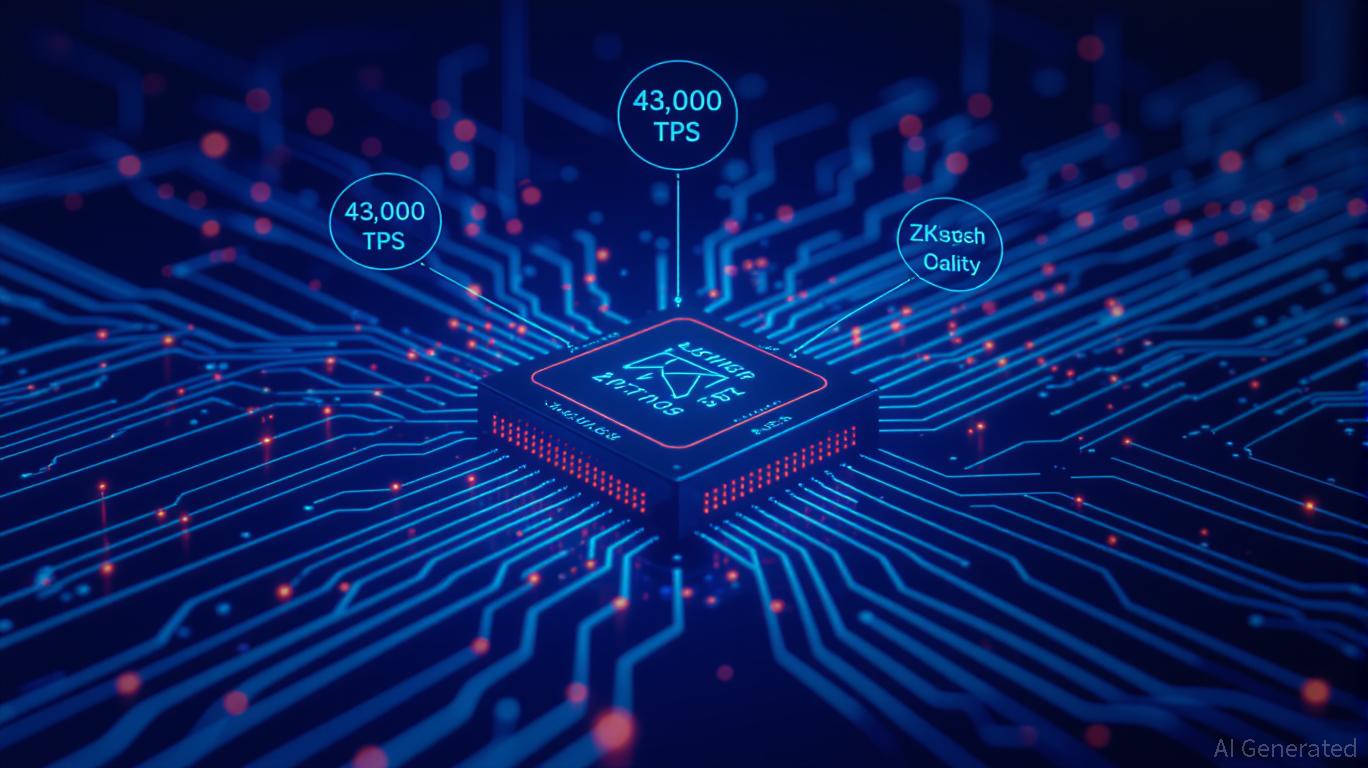ZK Atlas Upgrade: Transforming Blockchain Scalability and Driving Institutional Integration
- ZKsync's 2025 Atlas Upgrade introduces scalable ZK infrastructure with 43,000 TPS for ETH transfers, addressing blockchain's enterprise adoption barriers. - Technical components like Atlas Sequencer and Airbender prover enable sub-second finality, while ZKsync OS supports EVM compatibility and modular execution. - Institutional adoption accelerated by ZK Stack liquidity sharing and Vitalik Buterin's endorsement, with BlackRock's $1B tokenized fund leveraging ZK proofs. - Upcoming Fusaka upgrade aims to b
Technical Breakthroughs: The Architecture of Scalability
The Atlas Upgrade unveils three foundational innovations that transform ZK infrastructure: the Atlas Sequencer, Airbender prover, and ZKsync OS. These components collectively propel ZKsync to new heights in performance. For example, native ETH transactions can now reach up to 43,000 transactions per second (TPS) with finality in under a second, stablecoin operations achieve 15,000 TPS, and high-frequency oracle updates manage 23,000 TPS, all with latency ranging from 250 to 500 milliseconds
The Atlas Sequencer streamlines transaction ordering and processing, alleviating congestion found in conventional L2 systems. At the same time, the Airbender prover, which utilizes a RISC-V-based zkVM,

Institutional Adoption: From Technical Excellence to Real-World Impact
The technical advancements of the Atlas Upgrade have directly contributed to increased institutional uptake. Central to this is the ZK Stack, a suite of tools that facilitates effortless liquidity movement between Ethereum’s Layer 1 and Layer 2. This capability is particularly attractive to businesses aiming to maintain privacy while ensuring global interoperability, especially in sectors where regulatory adherence and operational performance are crucial
Importantly, Vitalik Buterin’s public support for the upgrade has further boosted its reputation. He emphasized ZKsync’s ability to handle 15,000 TPS and its ZK-powered scalability as essential for Ethereum’s institutional expansion
Practical deployments further highlight ZKsync’s significance for enterprises. By the fourth quarter of 2025, the platform had completed 1.2 billion transactions, with financial organizations utilizing its privacy-oriented ZK proofs for international payments and tokenized asset management
Future Outlook: Competing in the Enterprise Blockchain Arena
Looking forward, ZKsync’s planned Fusaka upgrade, which aims to raise throughput to 30,000 TPS, may further strengthen its competitive edge over rivals such as
For those investing, the Atlas Upgrade marks the transition of ZK infrastructure from an experimental phase to a fully operational platform. The intersection of technological progress, institutional alliances, and innovative tokenomics presents a strong case for sustained value, though potential regulatory changes and competition from other L2 solutions suggest a measured approach is prudent.
Conclusion
The ZK Atlas Upgrade illustrates how ZK infrastructure can close the gap between blockchain’s theoretical advantages and the practical needs of enterprises. By achieving high levels of scalability, privacy, and interoperability, ZKsync has not only transformed Layer-2 capabilities but has also accelerated the institutional embrace of Ethereum-based technologies. As the blockchain sector continues to develop, ZKsync’s strategic innovations ensure its role as a major force in the evolution of decentralized infrastructure.
Disclaimer: The content of this article solely reflects the author's opinion and does not represent the platform in any capacity. This article is not intended to serve as a reference for making investment decisions.
You may also like
The COAI Token Fraud: An Urgent Alert for Cryptocurrency Investors
- COAI token's 2025 collapse exposed systemic DeFi vulnerabilities, costing investors billions through regulatory loopholes and weak governance. - Scam operators exploited jurisdictional gaps in Southeast Asia and the U.S., with $10B+ annual losses attributed to AI token fraud and unclear CLARITY Act definitions. - Conflicting U.S. regulatory frameworks (SEC/CFTC) and partial measures in Hong Kong/Singapore highlight fragmented global oversight of crypto markets. - Cross-border enforcement (e.g., $13.4B se

Walmart Relies on In-House Leaders to Steer Through Retail Hurdles
- Walmart appoints John Furner, a 30-year veteran, as CEO in 2026, succeeding retiring Doug McMillion. - Furner, 51, leads U.S. operations with 4,600 stores and $120.9B Q2 revenue, emphasizing internal leadership continuity. - McMillion's 12-year tenure saw 400% stock growth but faces challenges like tariffs and affordability crises. - New CEO inherits AI-driven transformation goals, with Q3 earnings and SNAP benefit disruptions under investor scrutiny.
As traditional banks pull back, Tether rapidly steps in to meet the demand for commodity lending, offering both swift action and significant capacity
- Tether plans to expand commodity lending with $1.5B in credit, using $200B reserves to enter high-yield trade finance. - The move fills a void left by traditional banks, offering faster loans in minutes via USD and USDT, targeting emerging markets. - Hiring HSBC experts and leveraging gold reserves, Tether aims to bridge traditional and digital assets through its gold-backed token.

Bitcoin Latest Updates: Is the Crypto Bear Market Poised for a Rebound?
- Crypto Fear & Greed Index hits 16 (seven-month low) on Nov 14, 2025, reflecting extreme bearish sentiment driven by volatility, Bitcoin dominance, and risk-averse trading. - Bitcoin consolidates near $104,500 after breaking key support levels, with technical indicators suggesting potential $107,500 breakout or $100,500 decline based on ETF inflows and institutional activity. - Major altcoins like ETH, XRP , and BNB face critical support levels, while analysts cite Fed policy shifts and the GENIUS Act as
